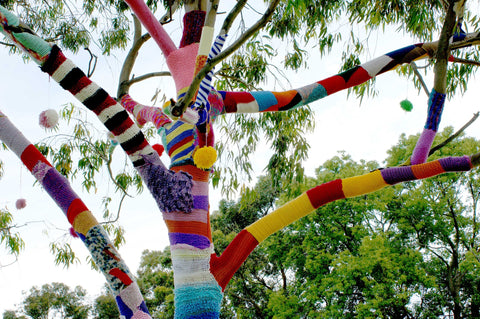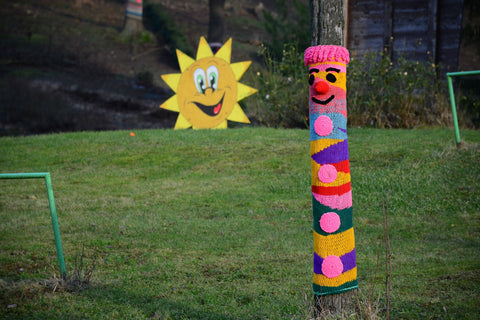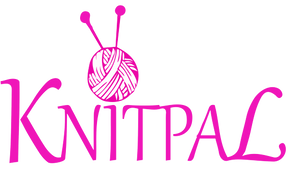
Your Guide to Yarnbombing and How to Make Your Yarnbombing Environmentally Friendly
Find out more about yarnbombing, how you can also become part of this art movement, and how you can keep your yarnbombing projects environmentally friendly!

What is yarnbombing?
Yarnbombing is a type of street art where the yarn is used in some form (knitted, crocheted, latch-hooked, cross-stitched, amigurumi or wrapped) to decorate an object in the public environment. It’s also called “knitfiti” by some as it reminds one of graffiti or even guerrilla knit and crochet.
According to Urban Yarnage, “Yarn bombing is now a national and international art movement that encompasses projects that range in scale from very small to extremely large”. Indeed, a yarnbomb installation can be as small as one creature in a tree, to a whole avenue of trees that have been decorated!
Yarnbombing artists
Artists like Magda Sayeg and Stephen Duneier have put yarnbombing on the map with their large-scale works like Sayeg yarnbombing a whole bus in 2008.
Fiber artists are now also coming together in groups to make larger yarnbomb installations. One example of this is the yarnbombing of the Santa Monica 18th Street Arts Centre.
At these large events, it’s also possible for experienced and not-so-experienced artists to come together and work on the same installation. This not only brings the community closer together but also goes to show that you don’t necessarily have to call yourself a “fiber artist” to take part in the fun art of yarnbombing!
Yes, you can yarnbomb too!
The great thing about yarnbombing is that everyone can take part, whether you’re part of a group or acting solo and no matter where in the world you are. It doesn’t even matter if you are living in the city, or in a small village!
The only thing you need to yarnbomb (except the yarn and needles or hook) is some creative inspiration and the need to make the world around you a more beautiful place.
Things to keep in mind when yarnbombing
When you’ve decided to take part in yarnbombing, and you’ve chosen the object that you’re going to yarnbomb — say a tree or street pole — you can start planning your project. You’ll need a fabric or other flexible tape measure to be able to take accurate measurements of the object as well as a notebook and pen (or your phone) to jot down the measurements.
Make sure that your yarnbomb will be able to stay in place — for instance on a vertical pole — and won’t slip down. Look for places that you can affix it to without damaging the object itself.
Next, decide whether you’re going to use a favorite repeating pattern, or perhaps are just going to go for garter stitch for now.
Now that you have the measurements and have an idea for the pattern, all that’s left is to gather together the colors of yarn that you want to use and start knitting or crocheting according to the measurements you took!
Thinking about the environment when yarnbombing
Before you go out and yarnbomb the town red, you should also keep the environment in mind; for instance, are you going to leave the artwork there until it naturally disintegrates or are you going to take it down again after a few days?
Especially if you plan to leave the art up, you need to keep in mind the materials that you’ll be using. After all, acrylic yarns are, basically, plastic and won’t disintegrate or break down with the wear and tear of weather. You can imagine that this can be very problematic when it comes to yarnbombing trees and little critters ingesting some of these man-made fibers.
Yarns to (rather) use when yarnbombing
The best choice for yarn for your yarnbombing projects are natural yarns that will break down through natural processes if left in place for any length of time. Rather than reaching for the cheapest yarn you can find for these projects, get out those scraps of natural yarns and wool. There are many different kinds of natural fibers that can be used — and the colors are no less vivid than those of the acrylic yarns. These fibers include animal, plant and protein fibers and you can find out all about them in this article about synthetic and natural yarn. Knitpal has a range of vivid and beautiful semi-solid colors that you can use in your projects and they are made from merino wool to boot!
Why not make your next yarnbomb project so much more environmentally friendly?
Why not show your team spirit with your next yarnbomb project?
Why only wear your team colors when you can let your environment show off your team colors as well? Next time you buy some Knitpal team spirit yarn, why not get a skein or two extra and let your campus, home, or neighborhood show its love for your favorite team!
What makes KnitPal wool so special?
KnitPal’s merino yarn mainly comes from Peru. The merino sheep are raised by small farmers in the Andes of Southern Peru — at an altitude of 11 500 — 16 000 ft above sea level. At this height, temperatures can differ by more than 50 degrees in one day. For this reason, the sheep grow dense coats of fleece that are not only extremely durable but also has a high thermal quality. KnitPal supports women-led farms by buying their yarn from them. But that’s not the thing that makes KnitPal’s yarns so very special, and neither is it that they are biodegradable (and therefore doesn’t leave a nasty footprint!); it is also the way in which they are hand-dyed with love and happiness.

Comments
This article is so helpful and I appreciate the generosity of this info. Do you recommend 100% WOOL then? Any patterns you might offer for a community proect? The photos are great! Thanks for being open and supportive.

